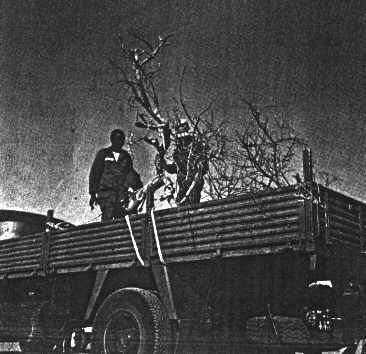| The Berliet-Ténéré
Mission was going straight to the Tree of Ténéré
on November 26 1959 and was very near when they deviated in order
to stop nearly 2km west, near a caravan of 400 camels escorted
by numerous camel drivers. They were the first men we had seen
since leaving Djanet, after having driven some 1066km. The cameramen
and the photographers didn't wish to miss the opportunity of seeing
them, and scorned the famous Tree...
But several among us
wished to see the Tree, and were driven to it. We didn't know
that the Tree was going to have the honour of being mentioned
in the Bulletin de liaison saharienne (no. 36 December 1959
pp 300-302).
To be precise about things,
the Tree is an Acacia tortilus Hayne, (kandili in Touareg)
situated on the large piste for camels Agadez-Fachi-Bilma, about
70 km close to ENE de l'Adrar Azzouager, in a full sandy region.
It is an incredible point, which is shown on all maps—though
there are other trees in the Ténéré, of
course.
It was surely known by
the French before 1914, when the first escorts of azalais started.
M. Abadie in La colonie du Niger (1927) relates his visit on
October 29 1921: 'The stump is entirely covered with sand, only
the superior branches can be seen'. I do not think that can
be true, because the surface of the sand seems stable in this
sector. The best proof is the comparison between the photo taken
by the Commandant N. Lesourd in 1939 with the one I took from
a different angle, unfortunately, in 1959. The level of the
sand seems identical and uniform, the curbs of the wells are
not under sand.
Today, two wells exist
there, separated only by four metres; one dated 1939 as M. Lesourd
related—Deeper than 35m they contained, when we went there,
more than 4m of water relatively less salt than other Sahara
water.
One, entirely lined with
cement, echoes when one speaks. The other is not the same. On
the curb of the well there is a tifinar inscription. A few names
are engraved or pencilled on the Tree, but that of my friend
from Touraine, Lamotte, compatriot who dug the first well.
One thing must also be
noted which struck me when comparing the 1939 and 1959 photographs.
The Tree is singularly diminished in volume over the last 20
years. It was the victim of an automobile accident; a military
lorry, backing, had broken one of its principal branches. This
branch had been sawn up and used, and the bit of trunk that
remained had been trimmed. The lower branches visible to the
right of the 1939 photo cannot be seen on the left of the 1959
photo taken on the opposite side. Is it not still considered
to be taboo?
Perhaps the explanation
can be that it appeared to be dead, M. Berliet certainly carefully
examined it, and discovered a branch with green leaves...
The Tree is still alive,
but it is seriously menaced. How long can it survive?
Coming back from Agadez,
the Berliet-Ténéré mission stopped 75 km
south-west of the Tree on the 3rd December for the evening halt
before crossing the erg in the direction of Gossolorom and Termitt.
We discovered there several
Neolithic and Palaeolithic strata in the sand-hills containing
snail shells. So, some 6000 years ago this was a verdant land.
The Tree of Ténéré is the last descendant
of the Acacia forests which certainly must have covered
the country. A real relic of vegetation of better times where
snails could venture without damage for hundreds of kilometres
from the actual habitat.
|


